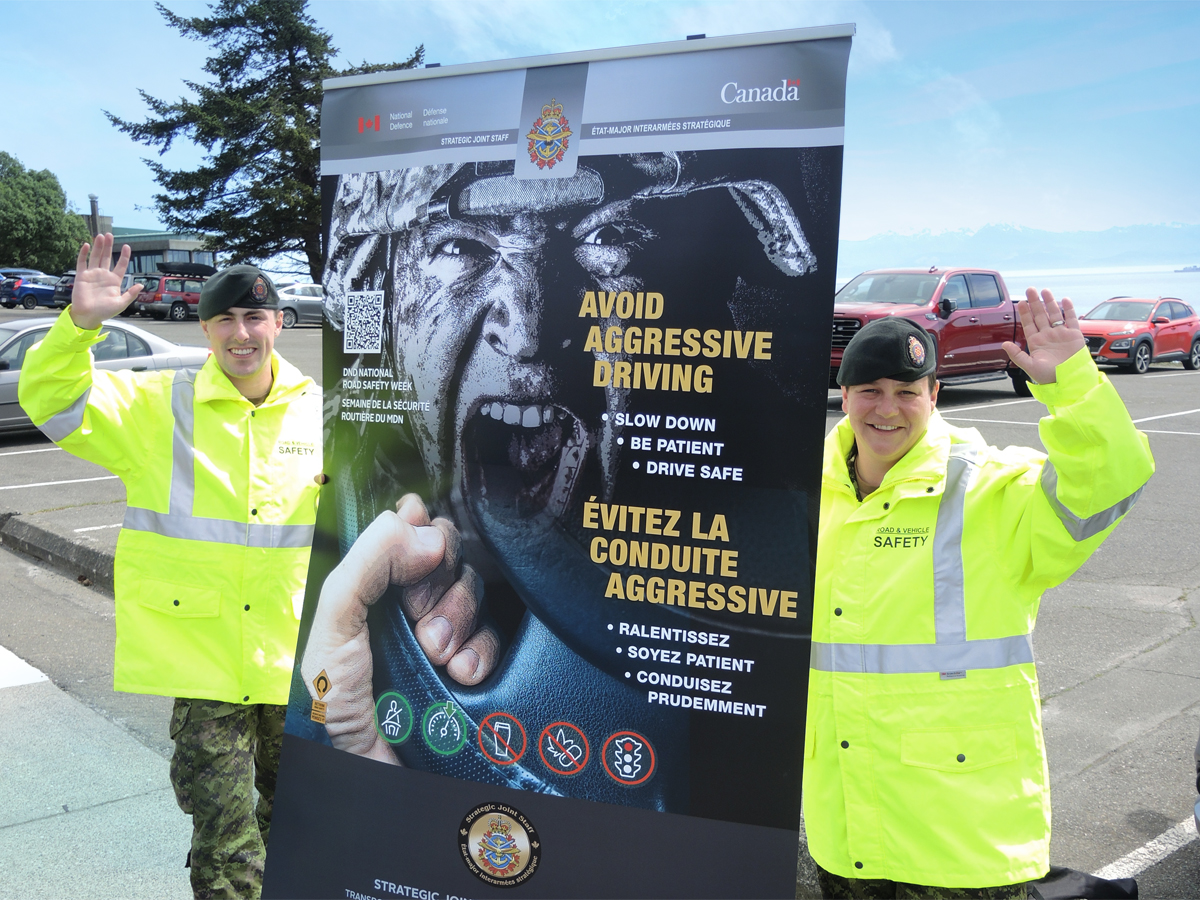No room for aggressive drivers
By Lookout Production on May 26, 2024 with Comments 0

Peter Mallett,
Staff Writer
—
The annual Drive Safe Campaign, hosted by the Transport Electrical Mechanical Engineering (TEME) unit, concluded on May 17. This year’s campaign focused on aggressive driving.
Sergeant (Sgt) Kylie Peterson of the Road and Vehicle Safety department says there is no sugarcoating what aggressive driving is.
“Aggressive driving is any unsafe driving behavior performed deliberately and with ill intention or disregard for safety,” said Sgt Peterson. “Cyclists can exhibit aggressive driving behavior as much as motorists and must also follow the rules of the road.”
The Road and Vehicle Safety department at CFB Esquimalt provides advice on collision and unsafe acts, as well as the insurance of DND 404 licenses.
As part of this year’s program, Sgt Peterson and Corporal Jones-Allen set up at the Naden and Dockyard Gates during rush hour each day last week. They reminded drivers of the serious risks of aggressive and unsafe driving and also checked their 404 licenses for validity. To sweeten the mood after the brief inconvenience, the team provided motorists with sweets.
“Everyone was in good spirits and candy seemed to start members off on the right foot for the day as well as on their ride home,” said Sgt Peterson.
Getting the Message
Despite the sweets and smiles, Sgt Peterson noted most of those who exhibit aggressive driving behavior are fully unaware of the seriousness and dangers of their actions.
Aggressive driving habits include speeding in heavy traffic, cutting in front of another driver and then slowing down, changing lanes without signaling or weaving in and out of traffic, blocking cars attempting to pass or change lanes, tailgating, running red lights, and using headlights or brakes to ‘punish’ other drivers.
The most staggering of all unsafe driving statistics, says Sgt Peterson, is that reckless driving violations increase the likelihood of being involved in a crash by 114 per cent. In comparison, following someone too closely increases the likelihood of a crash by 45 per cent. She says the best advice to avoid accidents and injury is by slowing down, staying alert and buckling up.
Sgt Peterson also offers facts and tips on aggressive driving to keep in mind, even if you aren’t the one at fault:
- Decrease the chances of a crash by giving yourself ample time to get to your destination.
- Safer traffic flow is managed with posted speed limits – slowing down in bad conditions increases your reaction time in an emergency.
- Tailgating reduces your visibility and reaction time.
- Passing a vehicle is safe when there is plenty of time to do so.
- Obscene gestures and the use of the horn out of anger help no one.
- Don’t provoke or allow yourself to be provoked.
- Be cautious, patient and forgiving – someone could be driving for the very first time in their life.
“CFB Esquimalt has a large bottleneck footprint, so we are encouraging members to plan accordingly and enjoy their day while maintaining safety on the roads,” Sgt Peterson concluded.
Aggressive Driving by Numbers
A comprehensive list of bad driving behavior and how it increases likelihood of a crash, compiled by TEME.
| If a driver had: | The crash likelihood increased: X% |
|---|---|
| A reckless driving violation | 114% |
| A failure to yield right of way violation | 101% |
| A failure to keep in proper lane conviction | 83% |
| A failure to use/improper signal conviction | 82% |
| A past crash | 74% |
| An improper lane/location conviction | 72% |
| An improper pass conviction | 70% |
| A reckless/careless/inattentive/negligent driving conviction | 69% |
| An improper or erratic lane change conviction | 66% |
| An improper lane change violation | 63% |
| An hours-of-service violation | 50% |
| An improper turn conviction | 49% |
| A following too close conviction | 46% |
| A speeding violation | 45% |
| A false or no log book violation | 45% |
| A disqualified driver violation | 44% |
| Any conviction | 43% |
| A speeding more than 15 miles over speed limit conviction | 40% |
| A speeding 1 to 15 miles over speed limit conviction | 38% |
| Any moving violation | 35% |
| A seat belt violation | 33% |
| A failure to obey traffic control device violation | 30% |
| Any OOS violation | 29% |
| A failure to obey traffic sign violation | 25% |
| A driving too fast for conditions conviction | 25% |
| A size and weight violation | 20% |
| A failure to obey traffic signal/light conviction | 20% |
Filed Under: News Release • Top Stories
About the Author:





